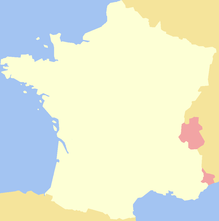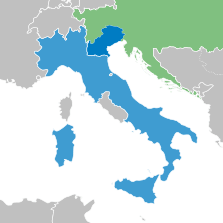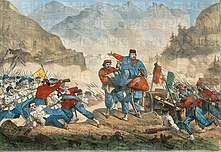Treaty of Vienna (1866)
The 1866 Treaty of Vienna was an agreement signed on the 3rd of October and later ratified on the 12th by the Kingdom of Italy and the Austrian Empire that concluded the hostilities of the Third War of Italian Independence [1], a theatre of concurrent Austro-Prussian War.
| Type | Peace Treaty |
|---|---|
| Signed | 3rd of October 1866 |
| Location | Vienna, Austria |
| Signatories | Austrian Empire Kingdom of Italy |
| Ratifiers | Austrian Empire Kingdom of Italy |
The treaty confirmed the terms of the August 12th Armistice of Cormons[1], resulting in the transfer of Venetia and most of Friuli to the French Empire, who then gave the region to Italy. This represented the final division of the Habsburg ruled Kingdom of Lombardy-Venetia, as the Lombard half had been ceded to the Kingdom of Sardinia in the earlier 1859 Treaty of Zurich. The treaty forced the Austrian government to recognise the sovereignty of the new Italian Kingdom. This coupled with the Prussian defeat of Austria made apparent the decline of the Habsburg Monarchy as a great power. The treaty also signalled the rise of Italy as the sixth great power of Europe[1].
Background

Since 1848 Italian nationalist societies[2] and the Kingdom Piedmont-Sardinia[3] had been trying to unify the post-Napoleonic Italian states into a single Italian nation. The main obstacle to Italian Unification was the Habsburg Monarchy, which directly or indirectly controlled much of Italy[4] and was actively invested in keeping Italy divided [2]. To overcome Austrian military might Piedmont (then Italy from 1861) would need to rely on foreign intervention by other European nations to overcome Austria. To this end the Piedmontese Prime Minister, Camillo Benso, Count of Cavour, forged an alliance with France, agreeing to turn over the French speaking provinces of Savoy and Nice to France in exchange for military support against Austria [4]. This support would be vital to Italian success in the Second War of Italian Unification, which resulted in the Austrians ceding Lombardy to Piedmont.
In mid-June of 1866 war broke out between Austria and Prussia over the administration of Schleswig and Holstein and the future of the German Confederation[5]. Italy took advantage of the situation by siding with Prussia in the conflict, declaring war on Austria on 20 June. The Italian government hoped that the ongoing Austro-Prussian campaign would allow their armies to flank the Austrian forces, seizing Venice, Friuli, Trentino, and Trieste with little difficulty. Austrian forces defeated the Italian Army at the Battle of Custova[1] and the Italian Navy at Battle of Lissa;[6] however, in the meantime, Giuseppe Garibaldi's volunteers had advanced in the direction of Trento in the invasion of Trentino, winning the battle of Bezzecca. Later, the Habsburgs were forced to seek an armistice with Italy due to the collapse of their northern armies following the decisive Battle of Sadowa and the rapid Prussian advance into Bohemia and towards Vienna. On 12 August, an armistice was signed by Austria and Italy at Cormons bringing an end to the fighting[1].
Provisions of the Treaty

Although Italy was on the winning side of the conflict, its poor military performance left it in a weak bargaining position at the negotiating table. As a result, Austria only agreed to surrender the land of the former Venetian Republic, which excluded the Italian speaking areas of Gorizia and Trieste[1]. Furthermore, Austria refused to give this land directly to Italy, instead handing it to the French Empire, who then gifted it to Italy, at last fulfilling their obligations to Italy for ceding Savoy and Nice. The Italians felt this was a humiliation and called for a plebiscite within Venetia, allowing them to decide whether or not to join the Kingdom of Italy, so that it could be said Venice joined the Italian Nation willingly[6]. The treaty also forced Italy to pay a cash indemnity for each Austrian fort present in Venetia, as well as requiring them to assume the state debt Venetia had accumulated while under Austrian control[1]. The treaty required Austria to formally acknowledge the existence of the Kingdom of Italy. Austria was also made to give Italy the Iron Crown of Lombardy, the crown used by the medieval Kings of Lombardy.
Consequences of the Treaty
For Austria the Treaty of Vienna and the concurrent Treaty of Prague with Prussia were national humiliations, one Austrian general remarked ‘that we [Austria] have sunk to the level of Turkey’[1]. As a result of the twin defeat to both Prussia and Italy the Austrian government incurred a massive state debt, throwing the government into turmoil. With the Empire on the brink of collapse the Viennese government was forced to partake in the 1867 Austro-Hungarian Compromise, which forced the Austrian government to grant significant autonomy to the Hungarian portion of the Empire. This resulted in the Empire being renamed as the Austro-Hungarian Empire and brought about greater equality between Hungarian and German speaking peoples of the Empire[1]. With the loss of Venetia Austrian influence on the Italian Peninsula established by the Congress of Vienna was brought to an end. All this combined reinforced the idea that Austria had become a second-rate great power.
The treaty brought the Italian state greater prestige and elevated its diplomatic position in Europe as a great power. However, due to Italy’s poor performance in the war Austria was able to retain several strategic mountains passes and mountain peaks in the Alps. This would have serious strategic implications for Italy during the First World War when fighting the in the Alpine Front against Austria[1].
Italian Unification

The Treaty of Vienna was a major milestone for the Unification of Italy, bringing Venice and the Veneto into the Italian State. After the war the Italian King, Victor Emmanuel, proclaimed that ‘Italy was made but not complete’[7]. Although the treaty secured Venetia for Italy, sects of the Italian government and many Italian nationalists, including Garibaldi, did not feel Italy had gained enough territory, with many had hoping the treaty would also gain Trieste and Trentino for Italy, with some going as far lay claim to the South Tyrol, Fiume (Rijeka), and the Dalmatian Coast [1]. This disappointment became the driving force of Italian Irredentism in the late nineteenth century. It would be this ongoing desire to claim Trieste and Trentino that would be the main cause for Italy’s entry into the First World War against Austria-Hungary. After the 1919 Paris Peace Settlement Italy’s territorial ambitions would be partially fulfilled with the acquisition of Trentino-South Tyrol, and Trieste, however, it was only under Mussolini that the full goals of 1866 would accomplished when Fascist Italy occupied the Dalmatian coast, an acquisition that was reversed following the end of the Second World War.
See also
References
- Wawro, Geoffrey (1996). The Austro-Prussian War: Austria's War with Prussia and Italy in 1866. 10 Stamford Road, Oakleigh, Melbourne 3166, Australia: Cambridge University Press. p. 281. ISBN 0-521-56059-4.CS1 maint: location (link)
- Berkeley, G. F.-H. (1932). Italy in the Making 1815 to 1846. Bently House, 200 Euston Road, London, N.W.1: Cambridge University Press. p. 10.CS1 maint: location (link)
- Guilherme, de Oliveira. "Extractive states: The case of the Italian unification". International Review of Law & Economics. December 2018, Vol.56: 144 – via Science Direct.
- Salvadori, Massimo (1861). Cavour and the Unification of Italy. 450 West 33rd Street, New York, N.Y. 10001: Van Nostrand Reinhold Company. pp. 74–76.CS1 maint: location (link)
- Tucker, Spencer (2018). The Roots and Consequences of Independence Wars: Conflicts That Changed World History. Santa Barbara, California: ABC-CLIO. p. 198. ISBN 9781440855993.
- King, Bolton (1912). History of Italian Unity 1814-1871 Volume II. Edinburgh: Ballantyne Press & Co. p. 299.
- Coppa, Frank (2013). The Origins of the Italian Wars of Independence. New York, NY: New York: Routledge. p. 131. ISBN 9781315846293.